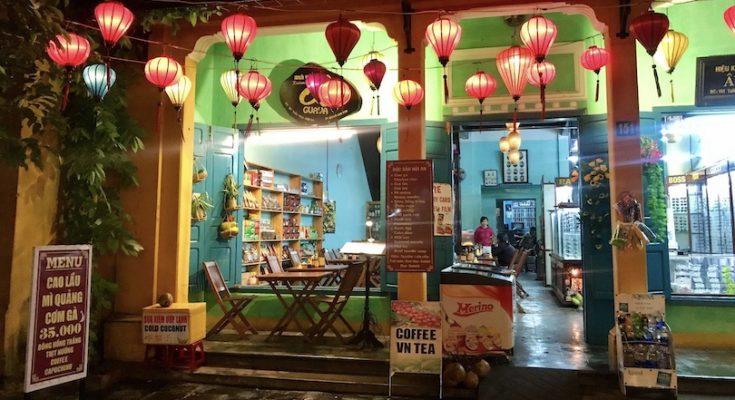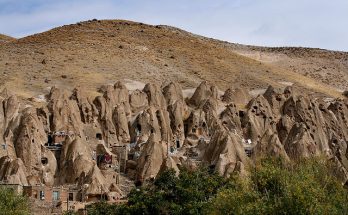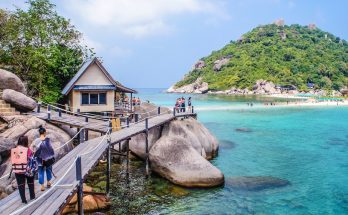Both one of the prettiest and best-preserved cities in Vietnam, Hoi An is located along its central coast, not too far south of nearby Da Nang. Although most known for its attractive Old Town that is home to hundreds of historic buildings, it also has a fantastic food scene, brilliant beaches and some great day trip destinations.
The two days I spent in Hoi An were easily the highlight of my time in Vietnam. Nestled along the Thu Bon River along the country’s picturesque central coastline, Hoi An is one of those places that can transport any traveler into another era.
It’s as if time has stood still here, where the roads have no cars, lanterns scatter the skies, and Vietnamese long boats cruise the river. Famous for its incredibly well-preserved Ancient Town, walking around Hoi An is a bit like stepping into a living museum.
I visited with a friend who had been to Hoi An countless times before. Safe to say, it was super helpful having a friendly ‘guide’ who could show me all the main attractions in Hoi And and best places to eat. Aside from enjoying its lovely ambience and eating everything you possibly can, other things to do in Hoi An can be found in the scenic countryside and the alluring Cham Islands nearby.
Map of Hoi An
A Brief History of Hoi An

There are few places you can visit where the entire town is a tourist attraction, and Hoi An is one of them. A UNESCO World Heritage Site, the town was founded in the 15th century, when it was a prominent trading port in Central Vietnam.
It became a bustling hub of international trade, attracting Chinese, Japanese, and European merchants. With this multicultural exchange of goods and ideas, it’s no wonder Hoi An became a melting pot of diverse cultures and influences.
The town has seen plenty of wars, natural disasters, and political strife, yet it has somehow managed to stay adaptable to these changes. Today, Hoi An stands as a living testament to its storied past. The incredibly well-preserved Ancient Town offers a glimpse into the town’s former glory, attracting tourists from across the world.
Getting From Da Nang to Hoi An

One of the most charming things about Hoi An is its lack of transportation. Not only are there no trains or busses, but the entire Ancient Town is car-less. If you have more than one day to spend here, I highly recommend renting a bicycle and joining the flowing river of cyclists that winds through the village.
Unfortunately, this also means your options for getting to and from Hoi An are limited. We were staying in Da Nang, a beachside city just up the coastline. We hired a private car that drove us directly from our hotel to the entrance to the Ancient Town in around 45 minutes. Depending on traffic, this trip could take between half an hour and one hour and costs around $20 per direction.
Another option is to hail a Grab car, which will cost less, between $10 and $15.
There is also a shuttle bus that runs on the hour from Da Nang Airport. The bus runs between 4 am and 10 pm and takes around an hour and fifteen minutes, depending on how many stops it makes. Most cabs and shuttles arrive at and leave from just outside the Ancient Town, at the crossroads of Nguyen Hue and Phan Chu Trinh or between Hoang Dieu and Tran Phu.
Old Town of Hoi An

From the moment I stepped foot in this town, I felt as if I was in an alternate reality. The charming streets are a clear example of colonial French and Japanese influences. Traditional yellow houses are covered in bright pink bougainvilleas and strung with lanterns in every color.

Streetside cafes spill onto the streets, where patrons sip traditional coffees as travelers ride past on their bicycles. The entire scene was something out of a fairytale.
While we had just indulged in a world-class hotel breakfast back in Da Nang, a second coffee never hurt anybody. We headed for one of the first cafes we came across, called Hoi An Deli, and ordered an iced Vietnamese drip coffee to-go for around $2 each.
Hoi An Central Market

Revved up with a caffeine boost, we headed towards the Hoi An Central Market (Chợ Hội An), which turned out to be one of the most impressive markets I visited in the country (and this says a lot).
The market was just a five-minute stroll through the Old Town along well-paved and flat roads. In fact, just about everything is within ten minutes’ walking distance of each other here.
Set along the banks of the Thu Bon River, the market dates back to the 15th Century and has been a bustling trading hub ever since. It stood through the rise and fall of the empires around it and has always been a commercial and cultural center of Hoi An.
Packed with a treasure trove of exciting finds, from traditional crafts, silk textiles, handmade lanterns, fresh produce, spices, and even a food hall. You’ll find every type of lime, green bean, and tropical fruit here, aesthetically displayed in brightly colored containers and woven baskets.
The market is divided into four main sections: spices and cooking utensils, fresh produce, prepared foods, and fish. It is open between 6 am and 6 pm, with fresh produce closing up shop a bit earlier. The best time to visit to admire the colorful produce is in the morning, when the produce is fresh, and the crowds are few.
Set aside a few hundred thousand Vietnamese Dong (VND) to spend on souvenirs and food here. A handmade lantern might cost around 200 thousand VND, for example.
Lunch at Tam Tam Jardin

With our appetites tickled by the market, we headed to a restaurant called Tam Tam Jardin for a bite to eat. A seven-minute walk along the river from the market, the restaurant had a cool interior decorated with dark wooden furniture.
I ordered a matcha latte and a chicken pho, and we split a portion of spring rolls and a lemon meringue tart for dessert. The entire meal cost around $8 per person, an absolute steal for the massive bowl of soup we struggled to finish.

In all honesty, while I recommend this restaurant any day, there are tons of other incredible restaurants worth checking out in Hoi An. Just about every second building houses a restaurant serving outstanding food.
Morning Glory, Home Hoi An, and Com Linh all come highly recommended for their traditional Vietnamese specialties.
The Tailor Shops of Hoi An

After lunch, we took a walk to Yaly Couture on Nguyen Thau Hoc, which my friend assured me was the best ‘overnight tailor’ in the town. She was right. Two hours flew by as we scoured fashion magazines for something that caught our eye. The tailors took my measurements, helped me pick out fabrics, and went off to sew my one-of-a-kind garment.
Hoi An is famous for its overnight trailers. There are plenty in the Ancient Town, all working through the night to create one-of-a-kind garments designed to fit. Since we had two days in Hoi An, our clothing was finished for us within an impressive 30 hours from start to finish (with a fitting after dinner on the first night).
Collecting our clothing the following day was a real treat. The talented tailors had sewed each garment immaculately, with careful attention to detail and the neatest seams possible. They weren’t cheap, costing between $50 and $100 per item, but they were incredibly well-priced for the personalized service and quick turnaround time. My only regret was not getting more things made by them.
Japanese Covered Bridge

Disclaimer: since I had two days in Hoi An, I didn’t want to rush through the Ancient Town’s significant landmarks, so I spread them throughout my visit. That said, since they’re all about a five-minute walk away from one another, it is entirely possible (and recommended) to visit them within one afternoon.
The Japanese Covered Bridge is one of Hoi An’s most iconic landmarks. The picturesque Japanese-inspired bridge is a symbol of Hoi An’s rich Japanese cultural and architectural heritage. It was built in the 16th Century and crosses the Thu Bon River. At the time it was built, it would connect the Chinese and Japanese sections of the town. Visiting the bridge is free, and you won’t need to spend more than ten minutes admiring the structure.
Tan Ky Old House

A three-minute walk east along the river sits the Tan Ky Old House, a historic home that blends Vietnamese, Chinese, and Japanese influences. It has an impressively well-preserved interior with carved wooden furniture and dark wooden beams, offering a glimpse into what life was like for the wealthy merchants of Hoi An.
The home is more than 200 years old, and it has passed through the hands of seven generations within the same Vietnamese family. Family members still reside in the Old House of Tan Ky, which brings the history of the property to life in a fascinating way.
To visit the house, you’ll need to pay 150 thousand VND and visit between 8 am and 5:30 pm.
Quan Cong Temple

One of the city’s most important places of worship, the colourful Quan Cong Temple lies right in the heart of Hoi An’s atmospheric Old Town. Known for its incredible art and architecture, it has an elaborate facade, fine frescos and plenty of other classical Chinese features to check out.
Built back in 1653, the well-preserved temple is dedicated to Quan Van Truong – a famous Chinese general who was known for his loyalty, integrity, sincerity and sense of justice. These qualities were of huge importance, as the coastal city had a thriving port and merchants needed to trust one another.
Once past its bright red, yellow and green entrance gate, you can explore the grounds full of statues and pay your respects in the sacred site’s incense-infused interior. As well as snapping photos of its delightful dragon motifs and majestic main altar, guests can also see a superb old statue of the revered general himself.
Old House of Phun Hung
The home of Phun Hung is two stories, and was built in the 18th century. More than eight generations of the same family have lived in the Old House of Phun Hung since then.
What makes this house truly unique, however, is the fact that it is more than just a museum: It is still a home, and the tour guide today is part of that eighth generation. Follow Ms. Anh around as she shows you her family home, and be on the lookout for the details that make the home unique.
You’ll see carved Chinese beam supports, trap doors and a distinct Japanese influence in both architecture and decor.
Cantonese Assembly Hall

One of the most popular attractions in Hot An is the Cantonese Assembly Hall. Also known as the Quang Trieu, the assembly hall sits right next to the Cau Pagoda. As the name suggests, the assembly hall was constructed by Cantonese settlers during the 19th century.
Dedicated to the Thien Hau Holy Mother, the Cantonese Assembly Hall was a gathering place for worship and communication among Chinese visitors and residents. On a tour of the Cantonese Assembly Hall, you can admire the structure as well as the decor, which includes a striking dragon made from pottery.
Fujian Assembly Hall

Phuc Kien is the common name for the Fujian Assembly Hall. Like other assembly halls in the city, Phuc Kien served as the gathering place for residents, traders and visitors from a specific area in China called Fujian.
Later, the assembly hall transformed into a religious site to honor the deity Thien Hau. Visiting the Fujian Assembly Hall means being able to spot the colorful fountains in the courtyard, the ornate gates surrounding the property and the beautifully carved dragons in the main room.
The Fujian Assembly Hall is still a popular place among visitors and residents of Fujian origin and ancestry.
Dinner at The Cargo Club

We finished our day with dinner at The Cargo Club, a restaurant with a terrace overlooking the river. Lit with moody lanterns and candles, this was the perfect setting to end a wonderful day. I ordered a traditional Vietnamese curry, which was served inside a burning coconut shell, with a sticky rice mango pudding for dessert. The meal was outstanding and cost around $10 per head (although you can expect to pay a bit more if you order wine or cocktails).
As we walked back to meet our driver, we passed hundreds of lantern shops selling beautiful handmade lanterns that filled the skies above the Ancient Town.
Hoi An Night Market

There is no shortage of shopping opportunities in the city, but one of the most interesting is found at the Hoi An Night Market. The market is located on Nguyen Hoang Street, just opposite the Japanese Covered Bridge.
The market opens around five each evening, when more than 500 vendors open up their stalls to sell everything from souvenirs to clothing to fresh food. Perhaps the most-spotted item for sale is the paper lantern, which glows beautifully after nightfall.

You can buy a colorful lantern to cast a glow as you shop, or you can take it home as a way to remember the colors, vibrancy and excitement of the Hoi An Night Market.
An Bang Beach

One of the busiest beaches in all of Vietnam is Hoi An’s An Bang Beach. If after all the sightseeing and strenuous outdoor activities you want to kick back, relax and soak up some sun, then An Bang Beach is definitely the place to go. Located ten minutes drive north of the center, its pristine white sands are lined by deckchairs and palapas with cafes and restaurants also dotted here and there.
Facing the shimmering East Vietnam Sea and far off Cham Islands, sweeping sands stretch more than four kilometers in total. Due to recent erosion at the neighboring Cua Dai, it is an increasingly popular place to head with countless hotels, guest houses and eateries having sprung up over the last few years.
Countless vendors are lined up under the shade of the palm trees to feed hungry beachgoers throughout the day.
Take a Bike Tour

A wonderful way to see more of the city and its scenic surroundings is to take a bike tour around its charming center and the bucolic countryside just outside. From the Old Town, numerous companies rent out bikes and motorbikes with some also offering leisurely cycling tours to the area’s traditional temples, villages and nature spots.
As you slowly peddle along, you’ll pass pretty paddy fields, reflective rivers and rural villages with frequent stops planned all along the way. These often take you off-the-beaten-path and along rickety bamboo bridges to little local artisans’ workshops and isolated islands along the river delta.

At each stop, your guide will provide more information on the region’s rich history and culture with many tours also including tasty lunches, too. Amongst the most popular excursions are those run by Heaven and Earth and Hoi An Cycle Tours.
Trip to Cham Islands

Not to be missed when in town, are the idyllic Cham Islands that lie just nine nautical miles offshore from An Bang Beach. Easily reached in half an hour by ferry or speed boat, the eight untouched isles have superb sunbathing, swimming, snorkeling and scuba diving to enjoy.
Now protected as part of a nature reserve and marine park, the mountainous archipelago is mostly uninhabited with only the largest island, Hon Lao, housing a couple of quaint fishermen’s villages. Aside from enjoying sightseeing cruises along their secluded shores, you can also stay overnight in guest houses to gain a greater understanding of local life.
The most fun things to do here, however, is undoubtedly enjoying the archipelago’s breathtaking beaches and snorkeling in the teeming coral reefs.
Trip to Mỹ Sơn

Another memorable trip you can make when visiting Hoi An is to the impressive and extensive archaeological ruins of Mỹ Sơn. The sprawling site is an hour’s drive southwest of the center with crumbling old religious buildings and ornate carvings on show.
One of the longest inhabited archaeological sites in Southeast Asia, the collection of Hindu temples was erected between the fourth and fourteenth centuries by the Kings of Champa. Often compared to other complexes like Angkor Wat in Cambodia and Bagan in Myanmar, the wide valley in which it lies encompasses around seventy temples and tombs.
Wandering around is an awe-inspiring experience. Intricately carved inscriptions and statues peek out from beneath the undergrowth that threatens to engulf the ancient edifices. While some temples are still in good condition, much of the site sadly suffered a lot of damage during the American War.
Take a Vietnamese Cooking Class

After having tasted so many delicious dishes during your time in Vietnam, why not take a cooking class so you can replicate your favorite pho and fresh spring rolls when you get home? In Hoi An, countless restaurants and cooking schools run fun classes that usually also include a trip around the local markets to source ingredients.
As you peruse all the market stalls laden with fresh vegetables and fragrant herbs, your friendly teacher will explain a bit about the history and culture of cooking in the country. Back at the culinary school or kitchen, they’ll then teach you how to prepare the food and make tasty treats like spicy mango salad, crispy banh xeo and sweet and sour fish soup.

As this is one of the most popular things to do in Hoi An there are many cooking school with Gioan, Red Bridge and the Kumquat BBQ Restaurant among the most popular. All of which put on unforgettable experiences that see you master Vietnamese classics in no time at all.
Tra Que Vegetable Village

Fervent foodies can go one step further and tour the tranquil Tra Que Vegetable Village which lies just to the north of town on the way to An Bang Beach. A peaceful and picturesque spot, its fertile farms and fields are famed for their fresh veggies that are used in Hoi An and the surrounding region.
Named after the sweet-scented vegetables that are used every day to spice up locals’ dishes, the small village has rows and rows of gorgeous green vegetable patches for you to amble around. In addition to taking scenic shots of the crops stretching endlessly into the distance, you can also watch the farmers prepare the soil, plant seeds and harvest their produce.
Visitors can even help sow vegetables themselves and sample some with both cooking classes and guided tours available at the laidback village.
Thanh Ha Pottery Village

One of the oldest pottery villages in Vietnam, the traditional Thanh Ha can be found just fifteen minutes drive down the Thu Bon River from the city center. Here you can watch master craftsmen at work and pick up some beautiful pots, statues and other ceramic products to remind you of your time traveling around the country.
Still home to dozens of pottery workshops and small, family-run ceramics businesses, the quiet little village was formed sometime in the sixteenth century. As you wander about its charming old streets, you can see talented artists fire up their kilns and create amazing artworks using ancient techniques.
Besides admiring the impressive potters as they shape the clay and conjure up lovely creations, you can also have a go yourself as classes regularly take place. Afterwards, make sure to stop by the Thanh Ha Terracotta Park for interesting exhibits on the art form and remarkable replicas of the Arc du Triomphe and Colosseum, among other famous landmarks.
Best Time to Visit Hoi An

Unlike further north in Vietnam, Hoi An only has two seasons, the rainy and the dry, though temperatures remain hot throughout the year. The most popular months to visit are July, August and December as this is when most Europeans take their holidays.
Due to the almost daily downpours and occasional floods, the low season is from September through January. December is an expectation though as most of its rain falls across just five days. As the cooler temperatures of 25 to 31°C (77 to 88°F) are perfect for sightseeing, its old town is packed with prices higher as a result.
As the temperatures and humidity are relatively low, February, March and April also see lots of visitors. Numerous important and exciting events like Vietnamese New Year and the Lady Thien Hau Procession also take place then.
While May and June are very quiet due to the high temperatures, July and August are again among the busiest and most expensive of the year. While it rains a little most days, you can still sunbathe at its nearby beaches or attend its Mid-Autumn Festival.
The 14th day of each lunar month also sees the magical Hoi An Lantern Festival light up its river and old town – an absolute must when in town.



